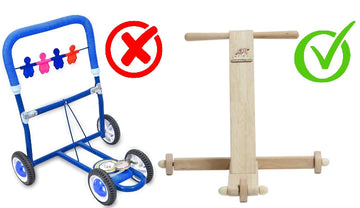When it comes to supporting your child’s first steps, the traditional push wagon is more than just a toy. It is a tool that helps them explore movement, coordination, and independence in a way that feels safe and empowering. In Montessori philosophy, the right walking aid is carefully chosen to match a child’s needs and developmental stage. But with so many options in the market, how do you select the ideal one for your child?
In this blog, we will walk you through the 3 most important factors to consider, along with tips on setting up the environment for confident walking practice.
1. It Should Be Completely Under the Child’s Control
A traditional push wagon should never dictate how your child moves. The key feature to look for is whether the wagon is fully child-driven. Your little one should be able to push it forward, pull it back, turn it sideways, start and stop, all at their own pace.
Walkers that move too quickly or have a fixed speed can cause the child to lose control, leading to falls or discouragement. Similarly, walkers that confine the child inside restrict their natural range of motion. In Montessori, movement is seen as a form of learning, so the push wagon should give your child the freedom to explore without limitations.
The goal is not just walking; it is about helping the child understand their own body, balance, and coordination. The more control they have over the wagon, the more confident and independent their walking practice will be.
CTA: Shop Child-Controlled Wagons
2. It Should Be Sturdy and Well-Balanced
When choosing a push wagon, sturdiness matters just as much as control. Look for a design that can hold at least 25 kilograms of weight. A well-built wagon offers stability, prevents tipping, and allows your child to lean on it for support without the risk of it toppling over.
Many commercial walkers are lightweight and made of plastic, which may tip over easily when a child pulls themselves up. A wooden push wagon is naturally heavier, providing a grounded base that moves only when your child pushes it intentionally.
Sturdiness also supports long-term use. A high-quality wagon will grow with your child, supporting them in the early walking stages and later becoming part of their pretend play and imaginative activities.
3. Keep It Simple
In today’s market, it is common to find walkers with flashing lights, musical buttons, and multiple play features. While these may seem appealing, they can distract your child from the primary goal, learning to walk.

A Montessori-aligned push wagon focuses on one purpose at a time. In this case, it should encourage movement without unnecessary add-ons that take away from concentration. Walking is a complex skill that requires focus, and too many built-in distractions can overwhelm the child.
Instead of choosing a walker with excessive features, opt for a simple design that keeps your child’s attention on their body movements, balance, and surroundings. This approach not only supports physical development but also builds mindfulness and self-awareness.
Setting Up the Environment
Selecting the right push wagon is only half the process. How you set it up in your home will directly impact your child’s walking experience.
- First, ensure that the wagon is easily accessible to your child. It should be stored in a place where they can reach it independently, without having to ask for help. This encourages self-initiated movement and independence.
- Next, choose an open space for practice. While it is important to clear sharp obstacles or tripping hazards, do not remove furniture entirely. Every day, objects like chairs or tables help children learn how to navigate real-life environments. They will develop the skill of moving around obstacles, adjusting their path, and controlling the wagon in different spaces.
- Finally, make sure there are no unnecessary distractions in the area. A calm and focused environment allows your child to engage deeply with the activity of walking. This could mean turning off the television, limiting noise, or avoiding spaces with too many toys scattered around.
CTA: Create the Perfect Walking Space
Why Montessori Recommends the Traditional Push Wagon
In Montessori philosophy, the push wagon is not just a walking aid; it is a developmental tool that supports multiple skills. By giving the child freedom of movement, it builds independence and confidence. By keeping the design simple, it promotes focus and concentration. And by making it sturdy, it ensures safety and stability for even the earliest walkers.
Walking is a major milestone in your child’s life, but it is also a deeply personal process. Every step they take is an opportunity to learn, explore, and gain control over their body. The right push wagon supports this journey without rushing it, making the experience joyful and empowering.
CTA: Explore Our Traditional Push Wagon










